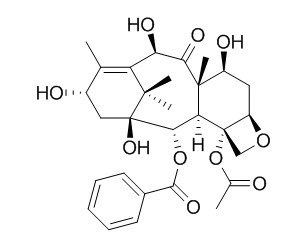10-Deacetylbaccatin III
10-Deacetylbacccatin III is an antineoplastic agent and an anti-cancer intermediate, it can selectively inhibit the growth of L. donovani intracellular amastigotes within J774 murine macrophages in vitro at nanomolar concentrations with an IC50 value of 70 nM.
The 10-Deacetylbaccatin III-treated promastigotes were slightly arrested in the G2/M phase whereas taxol-treated cells were blocked in the G2/M phase.
Inquire / Order:
manager@chemfaces.com
Technical Inquiries:
service@chemfaces.com
Tel:
+86-27-84237783
Fax:
+86-27-84254680
Address:
1 Building, No. 83, CheCheng Rd., Wuhan Economic and Technological Development Zone, Wuhan, Hubei 430056, PRC
Providing storage is as stated on the product vial and the vial is kept tightly sealed, the product can be stored for up to
24 months(2-8C).
Wherever possible, you should prepare and use solutions on the same day. However, if you need to make up stock solutions in advance, we recommend that you store the solution as aliquots in tightly sealed vials at -20C. Generally, these will be useable for up to two weeks. Before use, and prior to opening the vial we recommend that you allow your product to equilibrate to room temperature for at least 1 hour.
Need more advice on solubility, usage and handling? Please email to: service@chemfaces.com
The packaging of the product may have turned upside down during transportation, resulting in the natural compounds adhering to the neck or cap of the vial. take the vial out of its packaging and gently shake to let the compounds fall to the bottom of the vial. for liquid products, centrifuge at 200-500 RPM to gather the liquid at the bottom of the vial. try to avoid loss or contamination during handling.
Toxicol Mech Methods.2021, 1-12.
Food Chem.2024, 460(Pt 1):140472.
Fundam. Toxicol. Sci.2024, 11(4):197-204
Advances in Traditional Medicine2020, 10.1007
Biochem Biophys Res Commun.2020, 530(1):4-9.
Pharmacol Res.2020, 161:105205.
J Mol Recognit.2020, 33(2):e2819
Tumour Biol.2015, 36(9):7027-34
Pharmacological Reports2020, 1-9
Food Chem X.2024, 24:101909.
Related and Featured Products
Planta Med. 2007 Aug;73(10):1081-8.
In vitro activity of 10-deacetylbaccatin III against Leishmania donovani promastigotes and intracellular amastigotes.[Pubmed:
17691059]
Current treatments for leishmaniasis are unsatisfactory due to their route of administration, toxicity and expense but, most importantly, to the developed resistance of Leishmania to first-line drugs.
Therefore, the identification of new effective targeted drugs is an urgent need. Since many studies have shown that medicinal plants contain compounds active against protozoa we have undertaken a study aiming to determine the antileishmanial activity of the taxoid 10-Deacetylbaccatin III, isolated from dried needles and small branches of the European yew tree (Taxus baccata).
METHODS AND RESULTS:
Interestingly, 10-Deacetylbaccatin III was found to selectively inhibit the growth of L. DONOVANI intracellular amastigotes within J774 murine macrophages in vitro at nanomolar concentrations with an IC(50) value of 70 nM. Concentrations of 10-Deacetylbaccatin III as high as 5 microM did not affect J774 murine macrophages whereas 20 nM of taxol, used as a control, was toxic to macrophages. The compound also inhibited the growth of L. donovani promastigotes but at higher concentrations with a maximum level of inhibition of 35 %. Taxol inhibited promastigote growth at micromolar concentrations. Comparison of the effect of 10-Deacetylbaccatin III to that of taxol on cell cycle progression and cellular morphology showed that their mechanisms of action are different.
METHODS AND RESULTS:
The 10-Deacetylbaccatin III-treated promastigotes were slightly arrested in the G2/M phase whereas taxol-treated cells were blocked in the G2/M phase. In addition 10-Deacetylbaccatin III treatment, contrary to taxol, did not affect cellular morphology.
Yao Xue Xue Bao. 1998;33(2):132-7.
Effects of phenylalanine, sucrose and mannitol on the growth and production of taxol, baccatin III and 10-deacetylbaccatin III in suspension cells of Taxus media.[Pubmed:
11938949]
The effects of phenylalanine, sucrose and mannitol on the cell growth and the production of taxol, baccatin III and 10-Deacetylbaccatin III in the suspension cells of Taxus media were studied.
METHODS AND RESULTS:
The results showed that phenylalanine 1.0 mmol.L-1 or 2.0 mmol.L-1 initially added into the medium, and sucrose 73.0 mmol.L-1 and mannitol 173.3 mmol.L-1 added into the medium at the 28th d of culture strongly promoted the cell growth and the formation of the three taxanes in the suspension cells. Compared with those of the control, the cell biomass of the treatments supplemented with phenylalanine and added with sucrose and mannitol at the 28th d of culture increased by 0.6-0.8-fold, taxol yield by 9-10-fold, baccatin III yield by 2.5-3.0-fold, and 10-Deacetylbaccatin III yield by 7-fold. Addition of sucrose 73.0 mmol.L-1 at the 28th d of culture significantly promoted the cell growth, but showed little effect on the contents of the three taxanes in the suspension cultures.
Biol Chem Hoppe Seyler. 1994 Apr;375(4):281-7.
Immunological detection and quantitation of 10-deacetylbaccatin III in Taxus sp. plant and tissue cultures.[Pubmed:
8060537]
A high-sensitive ELISA method was developed for the detection and semi-quantitative determination of 10-Deacetylbaccatin III and its structurally related compounds in crude extract of Taxus sp. plants and tissue cultures.
METHODS AND RESULTS:
The antibodies were raised in rabbits using 7- or 10-succinyl-10-Deacetylbaccatin III-BSA conjugate as immunogen. The working range of the assay was from 0.003 to 1.000 ng (0.09 to 31.33 nM) of 10-Deacetylbaccatin III per assay. The cross-reacting material in crude plant extract was examined by chromatographic (silica gel CC, HPLC) and immunoassay methods. Study on the evaluation of cross-reacting material in crude Taxus plant extracts showed that at least 80% of the immunosignal correspond to 10-Deacetylbaccatin III in the extract. The ELISA method was applied to investigate the 10-Deacetylbaccatin III equivalent content in crude extracts of 19 plants species including Taxaceae, Taxodiaceae and Pinaceae species. The 10-Deacetylbaccatin III-like structure was only detected in Taxus and Torreya sp.
CONCLUSIONS:
The results indicate that this immunoassay is a useful tool for the rapid screening of species, varieties or individual plants out of a wide population. The distribution of 10-Deacetylbaccatin III equivalent content in 9-month old Taxus plantlets cultivated in vitro as well as in callus culture was investigated.



